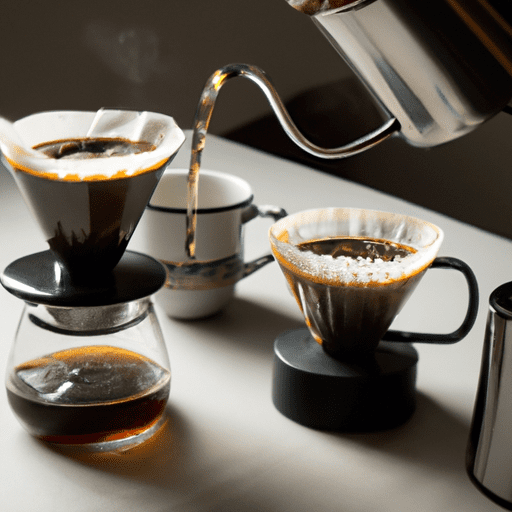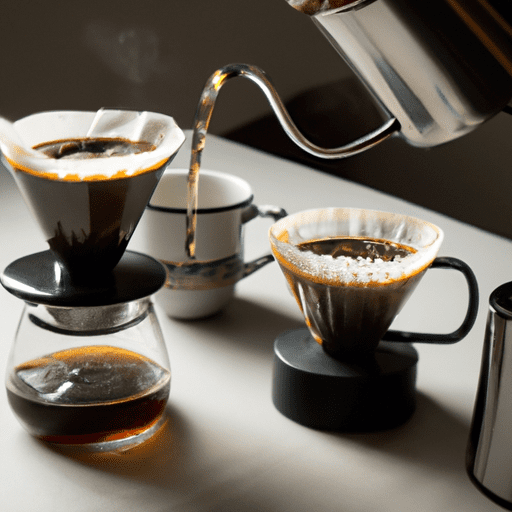Have you ever savored a homemade pour-over coffee and found yourself surprised by a bitter aftertaste? This article, “Understanding Why Your Pour Over Coffee is Bitter and How to Fix It” is your ultimate guide to combatting this issue. Whether you’re a beginner barista or an experienced coffee connoisseur, you’ll discover the reasons behind that unwanted bitterness in your morning cup of joe, and gain useful tips to remedy it. Now, let’s brew up some knowledge and perfect your pour-over coffee experience.

Common Reasons for Bitter Pour Over Coffee
You love your pour over coffee for its distinct flavor and aroma that elegantly kick-starts your day. However, there are times when it comes off as bitter, ruining your coffee experience. But fear not! Identifying the factors responsible for the bitterness can help you salvage and enhance your future brews. Here are some of the common culprits.
Why Coffee Beans Matter
Believe it or not, your choice of coffee beans plays a significant role in the flavor profile of your cup of Joe. Some beans bear a naturally bitter flavor due to their origin, growing conditions, and roasting process. While bitterness isn’t inherently off-putting and is often appreciated in moderation, an imbalance can lead to an overpowering taste.
The Importance of Grind Size
You might not realize it, but the grind size of your coffee beans can highly impact the resulting flavor. Too fine a grind size allows water to extract the coffee compounds too quickly, leading to over-extraction and a bitter taste. On the other hand, an overly coarse grind size results in under-extraction, producing a sour and weak brew.
The Impact of Water Temperature
We’re often tempted to use boiling water straight off the stove, but this can harm your coffee’s flavor. Too hot water can denature the delicate flavors, overpowering it with bitterness. The ideal water temperature range for pour over coffee is between 195 to 205 degrees Fahrenheit – to wholly extract the flavorful compounds without the undesirable bitterness.
The Role of Brew Time
Like water temperature, brew time plays a pivotal role in how your coffee tastes. If your coffee’s contact time with water is too long, it leads to over-extraction and hence a bitter taste. On the contrary, too short a brew time will lead to under-extraction, resulting in a weak, underdeveloped flavor.
The Significance of Water Quality
While it’s easy to overlook, the quality of water you use in your coffee can affect its taste. Tap water often contains impurities and minerals that may interfere with your coffee compounds, leaving behind an unpleasant bitterness. So, for an ideal pour over coffee, going for purified or bottled water can be a great choice.
How to Fix Bitter Pour Over Coffee
Having identified the common issues causing your pour over coffee to turn bitter, let’s now focus on how to fix them for a better tasting brew next time.
Selecting the Right Coffee Beans
Remember, the flavor starts with the beans. Opt for high-quality, freshly roasted beans from a local roaster if possible. Also, explore different varieties and origins to identify which flavor profile suits your palate the best.
Optimal Grind Size for Pour Over
Aiming for a medium-coarse grind size should be your standard point for pour over. However, feel free to experiment and adjust to taste. If your coffee tastes too bitter, make your grind a bit coarser. If it’s too sour, go a bit finer.
Controlling Water Temperature
Invest in a kettle with a built-in thermometer or an external coffee brewing thermometer to ensure your water temperature stays within the ideal range. This control can significantly improve the taste of your pour over coffee.
Adjusting Brew Time
Avoid leaving your coffee in contact with water for too long. Start with a brew time of 2 and a half to 3 minutes and adjust according to your taste. Some experimentation might be needed to find the sweet spot.
Improving Water Quality
Consider using bottled or filtered water for your coffee. If that isn’t possible, you could also try boiling your tap water and letting it cool to room temperature to remove some impurities.
Methods to Enhance Flavor in Pour Over Coffee
Now that you know how to fix bitterness, let’s elevate your pour over coffee further by discussing some methods to enhance its flavor.
The Bloom Technique
This involves adding a bit of hot water to your grinds to let them “bloom” or release gases before adding the rest of the water. This helps in enhancing the flavors and aroma of your coffee.
Experimenting with Extraction
Change up the water-to-coffee ratio, brew time, grind size, and water temperature to see how different variables affect your coffee’s flavor. It will take some trial and error, but it’s a fun way to make your perfect cup.
Utilizing Different Filters
Different filters can slightly alter your coffee’s character—from cloth and metal to paper filters. Each has its pros and cons, find what suits you best.
Using a Scale for Precision
Investing in a coffee scale can help you accurately measure your coffee and water, ensuring consistent results every time.
Storing Coffee Beans Properly
Keep your beans in an airtight container, away from light, heat, and moisture to retain their freshness and flavor.

Troubleshooting Bitterness in Pour Over Coffee
In case your pour over coffee still turns out bitter, here are some steps you can take to troubleshoot the issue.
Adjusting the Coffee-to-Water Ratio
Start by adjusting the coffee-to-water ratio as per your taste. A usual starting point is a 1:16 ratio, indicating 1 part coffee to 16 parts water.
Checking Water Temperature
Always maintain an optimal water temperature as excessively hot water can contain an undesirable bitterness in your coffee.
Examining Brewing Equipment
Inspect your brewing equipment to ensure no residual oils or coffee grounds are contributing to unwanted bitterness.
Exploring Different Brewing Methods
Pour over not doing the trick for you anymore? Try experimenting with different brewing methods like Aeropress, French press, or espresso.
Considering Roast Levels
Perhaps your beans are roasted too dark for your taste resulting in more bitterness—try a lighter roast for a more balanced flavor profile.
Factors Affecting the Taste of Pour Over Coffee
While we’ve touched on several factors influencing your coffee’s taste, let’s delve deeper into understanding how they work.
The Impact of Coffee Beans’ Origin
Coffee beans from different regions have different taste profiles due to variation in soil quality, altitude, climate, and harvesting practices. Experiment with different origins to discover which one suits your palate.
A Comparison of Roast Levels
Different roasting levels release different flavors in your coffee. Dark roasted beans can produce a stronger, more bitter flavor compared to light or medium roasts.
The Influence of Brewing Equipment
Your brewing equipment—from the type of kettle to the filters and the coffee maker itself—can affect the taste of your coffee.
Water Composition and Its Effect
Water with high mineral content can interfere with the extraction process, leading to a flat or bitter taste. Water with balanced mineral content can help extract a good blend of flavors from the coffee.
The Interaction of Brew Time and Extraction
Brew time directly affects extraction, i.e., the longer the brew time, the more flavors will be extracted, but also the more potential for bitterness. Aim for a balanced extraction.
The Role of Coffee Beans in Bitterness
Let’s focus more on coffee beans—their varieties, roasting levels, and storage methods—and how they contribute to bitterness in your pour over coffee.
Understanding Bean Varieties
There are two main types of coffee beans—Arabica and Robusta. While Arabica beans are more complex and aromatic, Robusta beans tend to be more bitter and contain more caffeine.
Identifying Over/Under Roasted Beans
Over-roasted beans have a burnt, bitter taste, and under-roasted ones are often sour. Understanding roast levels can help you choose beans that provide a balanced flavor.
Exploring the Different Roasting Processes
From light to dark roasts, every level extracts different flavors from your beans. Experiment with different roast levels to see which one yields your preferred taste.
Storing Beans to Maintain Freshness
Freshness is critical for preserving the natural flavors of your beans. Always store your beans in an airtight container, away from heat, light, and moisture.
The Importance of Grind Size for Flavor
The grind size can dramatically change your coffee’s flavor. Let’s break down how to find the ideal grind size and avoid over- or under-extraction.
Finding the Ideal Grind Size
Finding the perfect grind size might require some experimentation. Grind a few beans and brew small amounts, tweaking the size until you get the perfect flavor. Remember, for pour over, the size should be medium-coarse.
Adjusting Grind Size for Different Brewing Methods
Every brewing method requires a different grind size—from coarse for French press to fine for espresso. For pour over, you want the grind to be somewhere in the middle.
Understanding Extraction with Finer or Coarser Grinds
Water takes a longer time to pass through finer grinds, leading to over-extraction and a bitter taste. On the other hand, water quickly passes through coarser grinds, leading to under-extraction and a weak, sour taste.
Avoiding Over-Extraction and Under-Extraction
Understanding the correlation between grind size and extraction can save your brew from being overly bitter or weak. Adjusting your grind size to achieve the ideal extraction is key in this regard.
Controlling Water Temperature for Optimal Taste
Water temperature is pivotal when it comes to achieving a perfectly balanced pot of drip coffee. Let’s go over some key points regarding this aspect.
Ideal Water Temperature for Pour Over
The optimal water temperature for pour over coffee is 195 to 205 degrees Fahrenheit. Using boiling water can lead to over-extraction and bitterness.
The Consequences of Using Incorrect Water Temperature
Too hot water can result in a bitter brew by over-extracting undesirable flavors. Similarly, too cold water might not extract sufficient flavor, leading to a weak and underdeveloped coffee.
Preheating Equipment and Calculating Brew Time
Preheating your brewing gear with hot water before use can help maintain an optimal brewing temperature throughout the process. Furthermore, keeping an eye on your brew time can help avoid over-extraction and ensuing bitterness.
Using a Thermometer or Kettle with Temperature Control
Investing in a brewing thermometer or a kettle with temperature control can help ensure your water is always in the optimal temperature range for brewing pour-over coffee.
The Role of Brew Time in Bitterness
Lastly, let’s understand how brew time can influence the bitterness in your coffee.
Optimal Brew Time for Pour Over
The ideal brew time for pour over coffee ranges from 2 and a half to 3 minutes. However, feel free to adjust this according to your taste.
The Connection Between Extraction and Brew Time
Longer brew time means more extraction, which, if not controlled, can lead to a bitter coffee. Aim for a balanced extraction to promote a balanced flavor profile.
Understanding How Different Factors Impact Brew Time
Several factors can affect brew time—from the grind size and water temperature to the coffee-to-water ratio. Recognizing how these elements interact with each other can help you gain greater control over your brew time.
Adjusting Brew Time for Desired Strength and Flavor
Prolonged brew time can intensify the flavor and strength of your coffee. However, avoid over-extracting, which often results in a bitter brew. Hopefully, you now feel better equipped to troubleshoot any issues and create an excellent pour over brew. Happy brewing!
